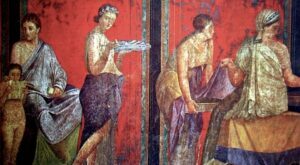
One often hears the phrase, the “American Dream.” It conjures up a sweet life, to wit: a good job, money in the bank, a big, airy house and neat green lawn, a luxurious car, a happy marriage with beautiful children, all in a charming neighborhood.
For the ancient Roman, the dream was a bit more ambitious, though not altogether unfamiliar to us in our day: professional success, affluence in abundance, a thriving family, influential friends, and then the best of both worlds: a fine house in a prosperous quarter of the city – say on the Aventine or Esquiline Hill—and by all means a cozy, attractive villa out in the countryside, or by the sea, or a lake, for a periodic taste of true leisure—the Romans called this contemplative life in the country Otium.
Here the writer explores and examines some of the famous people, history, luxury, and role of the villa in Roman life. The handsome remains of numerous such retreats excavated in Pompeii and Herculaneum, for example, afford us a tangible idea of their general architecture and appearance….
A roman villa—what did it look like?
Usually very large, the villa was rectangular in shape, a one-story dwelling with a vestibule open to the street, leading to the main door (ianua) which opened onto the atrium or living room. This was a sizable square space centerpieced by a shallow pool (impluvium) customarily filled with rain water that fell through a matching opening in the roof (compluvium). Bedrooms (cubicula) surrounded and gave onto the atrium. On the far end of this was a tablinum, a larger chamber used as an office. This exited onto the peristylium, a colonnaded outdoor court where the family loved to pass a good part of the day, strolling around and around the enclosed garden often centered with a statue or sundial or, best of all, a fountain. More bedrooms and guest rooms faced this refreshingly cool, airy yard. Also at the far end on the one side was the biblioteca, a reading room,. Opposite this was the largest room of the house, the triclinium, or dining room.
This home (domus) was surrounded by meticulously landscaped grounds featuring flower beds punctuated by marble sculptures. There was sometimes an in-the-ground pool for bathing. All in all, the Roman villa was the proverbial “lap of luxury.”
____________________________

The plan of the famous Villa of the Papyri at Herculaneum, integrating most of the elements of a Roman villa. Public Domain, Wikimedia Commons
____________________________
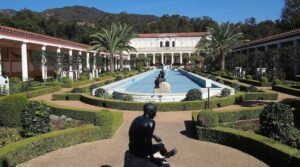
Above and below: the Getty Villa in California is a reconstruction of the Villa of the Papyri, the remains of which are still under excavation in Herculaneum. It is an iconic example of a Roman villa. Above Image: Malasoca, Pixabay
____________________________
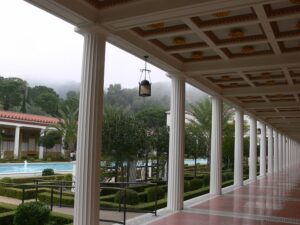
Remi Mathis, CC BY-SA 4.0, Wikimedia Commons
____________________________
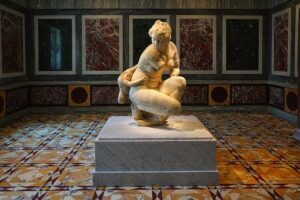
Venus and Eros in Marble Room, at the Gety Villa. Scotwriter21, CC BY-SA 4.0, Wikimedia Commons
____________________________
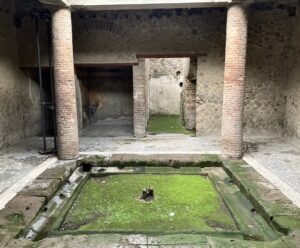
Above and below: examples of the impluvium in villas excavated at Pompeii.
____________________________

____________________________
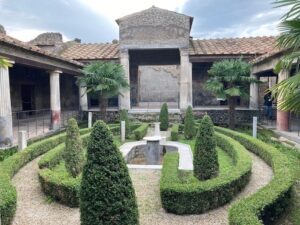
A peristylium at a villa in Pompeii.
____________________________
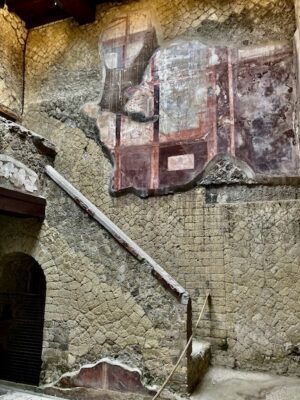
Above and below: remains of interior villa grandeur as excavated at Herculaneum
____________________________

____________________________
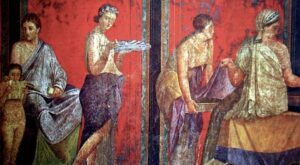
Some of the finest examples of wall painting in ancient Rome can be found in the villas. Here, a detail of women from the wall painting at the Villa of the Mysteries, Pompeii. Public Domain, Wikimeda Commons
____________________________
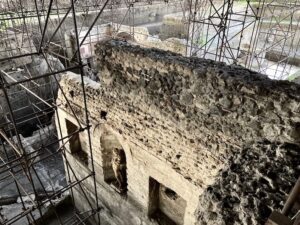
Above and below: the Dionysiac Villa (Villa of Augustus), a massive villa still under excavation near the slopes of Mount Vesuvius. It is an example of a later period villa. This one also served as part of a wine-producing enterprise.
____________________________
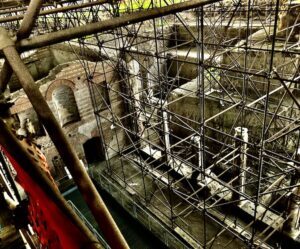
____________________________
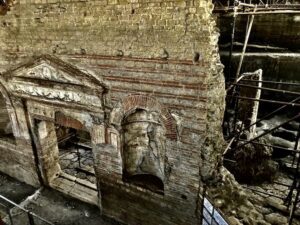
____________________________

____________________________
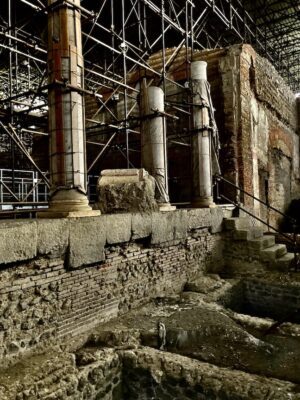
____________________________
Cicero and His Luxury Spaces

Bust of Cicero, at the Palazzo Nuovo – Capitoline Museums – Rome. José Luiz Bernardes Ribeiro / CC BY-SA 4.0, Wikimedia Commons
This peculiarly Roman institution, the villa, began to really come into vogue in the first century B.C., especially in the heyday of such squires as Marcus Tullius Cicero. Born and raised in the rugged hilltown of Arpinum (now Arpino) some sixty miles south of the capital, this country lad never forgot his rural roots. The mountainous terrain, the lush vegetation, the soft air of the Italian countryside remained forever in his blood. Even in the years ahead when he was busy climbing the political ladder all the way to the Consulship, in 63 B.C., Cicero always managed to set aside time for yearly visits to his ancestral home.
His father, wanting to afford the children, the educational advantages and career opportunities of the big city, had moved the family to Rome when Marcus was in his early teens. Early on, the young man showed a keen interest in the practice of law and eventually clerked under the pre-eminent trial lawyer of the day, Quintus Mucius Scaevola. Cicero’s rise in the profession was meteoric. When at age 26 he won the celebrated Sextus Roscius murder case, he became the talk of Roman high society.
With his success in the courts, and subsequent triumph in politics, came an affluence he could never have imagined back in old Arpinum. He purchased a fashionable home on Rome’s ritzy Palatine Hill. As his financial resources continued to multiply, he invested in more and more property outside the city, starting with the purchase of a splendid villa (once owned by the powerful dictator Lucius Cornelius Sulla), high up in Tusculum in the Alban Hills, about fifteen miles south of Rome. He named his new acquisition “My Tusculanum.”
Such was his attachment to villa life that he soon acquired another vacation home at Antium on the shore of the eponymous bay. (Today we know it as Anzio.) From his sumptuous villa there in April of 59 B.C., with the warm air redolent of the salty sea, Cicero writes to his friend Atticus: “I have fallen so in love with leisure that I cannot tear myself away from it. Thus I go fishing or take delight in my books of which I have a happy abundance here. Sometimes I just sit and count the waves. (Sedeo et fluctus numero.)” (Note: In January of A.D. 1944 the descendants of those same waves would bring to shore the landing craft of the British-American forces seeking to liberate Rome and all of Italy from the Nazi stronghold.)
He next bought a villa at Astura, on the same bay.
Cicero went on, across the next several years, to purchase five more – seven in all – posh retreats down further along the coast, at Formiae (Formia), halfway between Rome and Neapolis (Naples); at Cumae, Pompeii,and Puteoli (Pozzuoli), all on the curving shore at the Bay of Naples. He liked to refer to them collectively as “My dear villas, the Gems of Italy.”
Cicero found one drawback, though, with the Bay area, for there was a multitude of Roman senators and other city officials with abodes in this region, people he was trying to get away from on his vacations. From Cumae in a letter to his close pal he laments: “Habemus hic quasi pusillam Romam.” (We have here an almost miniature Rome.) He then goes on to mock the uppity rich for their garish and ostentatious shore-homes, and their elaborate dinner parties “at which they all try to outdo one another in extravagance.” The writer Julia Fiore cleverly called this locale with all its soirees, “The Hamptons of Rome.”
___________________________

Above and below: views of the excavated remains of Villa Sora (Torre del Greco), one among many such villas along the coast of the Bay of Naples. It is still under excavation.
___________________________

___________________________

___________________________
Of all his land holdings he preferred by far his house in Tusculum. This we learn from his correspondence with his lifelong alter ego, Atticus: “Mire quam illius loci non modo usu, sed etiam coqitatio me delectat.” (It’s remarkable how the mere thought of this place delights me even when I’m not there.) The letters also reveal Cicero’s eagerness to adorn the place with precious art works: “If you see anything that would go well in my Villa Tuscolana please be sure to bring it back for me.” We see too his interest in putting together a well-stocked private library. He pleads with the highly cultivated Atticus: “Don’t promise your book collection to anyone no matter how much they offer for it. I’m saving up to buy it for my golden years.”
Whenever he had his fill with the pressures and phoniness of the Roman political scene, Cicero would pack himself off to Tusculum for a few days. “Nam nos ex omnibus molestiis et laboribus uno illo in loco conquiescimus.” (Only there can we find relief from all annoyances and toil.)
There he loved to walk among his vineyards and olive groves, to sit in his courtyard discussing lofty topics with interesting overnight guests, to host small dinner parties, and to take in the magnificent views out over the countryside toward Rome. There in his marble-paneled and handsomely appointed study he enjoyed reading and answering his mail. Out in the gardens he delighted in plucking and tasting fresh fruit from the fig trees. On a balmy afternoon he would take the cool shade of an umbrella pine while he indulged his insatiable reading appetite. “enim otium est dulcius otio literato?”. (For what is sweeter than leisure filled with literature?}
It was to his cherished Villa Tuscolana that Cicero retreated for consolation following the death – at childbirth – of Tullia, the bright and beautiful thirty year old daughter whom he loved beyond all words. It was there too where in the twilight of his life he researched and wrote his philosophical treatise, “The Tusculan Disputations.” In a letter to Atticus during that period he informed his friend how he dealt with his grief: “I sit here and write from morning till night.”
____________________________
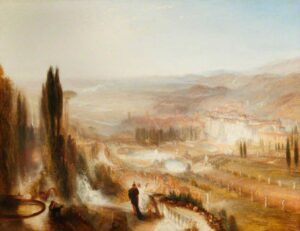
Turner, Joseph Mallord William; Cicero at His Villa at Tusculum; National Trust, Ascott; http://www.artuk.org/artworks/cicero-at-his-villa-at-tusculum-216764, Public Domain, Wikimedia Commons
____________________________
Because of his turbulent political career, his extensive writings: essays, legal briefs, speeches, dissertations, and rich, newsy correspondence, and his elegant lifestyle, Marcus Tullius Cicero comes down to us as surely the most human, the most believable, the most three-dimensional and interesting character of the Classical era. It is fun to imagine him, toga-clad, strolling down the cypress-lined lanes of his beloved Tusculanum. How he lavished praise and unabashed sentimentality and heartfelt affection for it in his correspondence – something he was disinclined to do in conversation. For, as he liked to point out: “Epistula non erubescit.” (A letter doesn’t blush.)
Horace and His Country Retreats
In 65 B.C., while Cicero was making legal,oratorical, and political headlines in Rome, there was born in Venusia (Venosa), a humble town nestling in the Apennines near the border of Lucania (Basilicata) and Apulia (Puglia), a boy destined to make his mark as a brilliant poet, Horatius Flaccus. The whole world came to know him as Horace.
His doting father, who early on noticed something special in the lad, sent him, at the tender age of seven, to school in Rome. Through the years, he excelled academically, demonstrating in particular a talent for composing verse. After his school days he became a ‘starving poet’ (a rather redundant term in most cases). But some of his work caught the attention and admiration of a much acclaimed poet named Virgil. Seeing much promise and future greatness for Horace, he became a dear friend who, noblesse oblige, did all he could to foster the career of the extremely likable, small-town young man, even introducing him to Maecenas, a wealthy patron of literature who happened also to be a close advisor to Emperor Augustus.
When one day Maecenas asked how his writing was going, Horace lamented that producing good verse in Rome was nigh impossible, what with the pulsating urban lifestyle, the frenzy, the din, the crowds, the social obligations. The patron brought this to the attention of the Emperor, who was also interested in promoting all things cultural, and persuaded Augustus to grant the struggling poet a bit of public land in the irenic Sabine Hills, not too far from the capital. Along with a modestly paying clerkship in the government, with few, if any, duties – a virtual sinecure – it alleviated Horace’s concern about earning a living and afforded him much free time to spend at this country villa/farm to hone his craft. Horace expressed his gratitude in a delightful verse: “The choir of poets all cherish the quietude and beauty of the woods and shun the city.”
In one of his odes, Horace gushes over his Sabine retreat. Gilbert Highet superbly translates the Latin lines thus:
This was one of my prayers, a little space of land
With a garden, near the house a spring of living water
And a small wood besides. Heaven has fulfilled it
Better and richer than my hopes.
Soon Horace found a prominent publishing firm, the Sosii Brothers, eager to mass-produce his many manuscripts. For all this newfound success, he credited his dear patron, who was like a second father to him. Elated, Maecenas bought the poet another villa, quite spacious and elegant, on the outskirts of the city of Tibur (Tivoli). Horace was enthralled with the house and its manicured grounds and quickly dashed off an invitation to his benefactor:
Tibi non ante verso lene merum cade iam dudum apud me est. Eripe
Te morae!
(An amphora of untapped wine is waiting for you here at the villa.
Try to break away and come over soon!)
An older writer, Lucretius, also had acquired a retreat in the hills where he could concentrate more clearly. But it seems that he didn’t care for extended sojourns there. He would often remark that, “Restlessness drives a man from Rome to his country villa. Boredom drives him back.”
Even Horace had this ambivalent emotion: “Romae amem Tibur, ventosus-Tibure Romam.” (At Rome I yearn for Tibur, then as shifting as the wind, at Tibur, for Rome.)
And Cicero too, for all his love for his villas, often said: “Ah, Rome. Dear Rome. Residence anywhere else is merely exile.”
__________________________
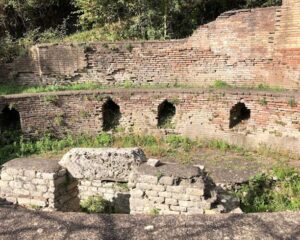
Above and below: remains of baths at Horace’s villa near Licenza, Italy. Rjdeadly, CC BY-SA 4.0, Wikimedia Commons
__________________________
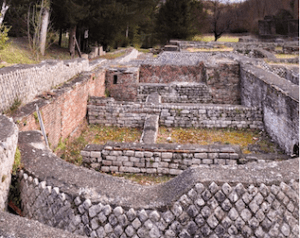
__________________________

Fountain remains at the Horace villa. Rjdeadly, CC BY-SA 4.0, Wikimedia Commons
__________________________
An Island Retreat for Emperors
The private villa craze among the upper class Romans spilled over into the next century. The Emperor Augustus (63 B.C. – A.D. 14) late in life found his own “paradise on earth” on the enchanting island of Capreae (Capri) in the Bay of Naples, three miles out from the promontory of Surrentum (Sorrento), and built a sumptuous villa there on the highest plateau, for getaways from the sultry Roman summers. His dearest friend and sort of “prime minister” Marcus Agrippa, had some years earlier found vacations on the bay appealing too, and acquired a house on the mainland there, on the slope of Mount Vesuvius with its breathtaking panorama out over that tranquil part of the sea. (At the time no one yet knew that Vesuvius was a volcano, for its slopes were rich with vegetation and dotted with vineyards, an ideal and idyllic site for stately villas, or so it seemed, until August 24, A.D. 79.)
In their English language volume, The Complete Works of Tacitus, the classicists Alfred Church and William Brodribb cite the historian telling us about Augustus’ successor Tiberius and his enthrallment with Capreae to the point where he abandoned his imperial palace in Rome in A.D. 27 never to return, choosing to rule the vast Empire from the tiny isle for the last ten years of his life:
The solitude of the place was, I believe, its chief attraction. Its air in winter is soft as it is screened by a mountain which protects against biting winds. In summer it catches the western breezes, and the sea around it renders it most delightful. Tiberius filled the island with twelve country houses, each with a grand name and a vast structure of its own. Intent as he had once been on the cares of State, he wanted now to unwind in total leisure and luxury.
The flagship property of all twelve was his Villa Jovis (an alternate name for Jupiter, king of the Roman deities), the extensive ruins of which are open for guided tours (see images below).
_______________________________
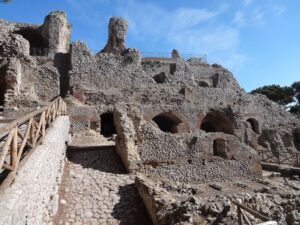
Above and below: Views of the archaeological remains of the Villa Jovis. Above image credit Derbrauni, CC BY-SA 4.0, Wikimedia Commons
_______________________________

Mister No, CC BY-SA 4.0, Wikimedia Commons
_______________________________

https://www.flickr.com/photos/tylerbell/, CC BY-SA 4.0, Wikimedia Commons
_______________________________
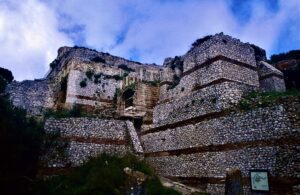
https://www.flickr.com/photos/tylerbell/, CC BY-SA 4.0, Wikimedia Commons
_______________________________
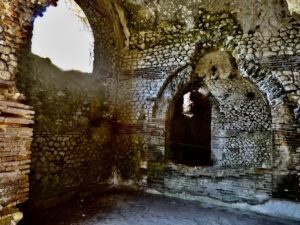
Derbrauni, CC BY-SA 4.0, Wikimedia Commons
_______________________________

Reconstruction drawing of Villa Jovis. Carl Weichardt (1846-1906), Public Domain, Wikimedia Commons
_______________________________
According to the author Tacitus, the mentally unstable Emperor Nero also liked to escape the relentless heat of a Roman summer with periodic brief getaways at the opulent bayside villa he had established at Antium, which happened to be his birthplace and childhood residence. Tacitus puts the lie to the age-old legend that Nero, when informed that Rome was engulfed in flames in July of 64, gleefully watched the conflagration from his palace balcony there and sang of the burning of Troy. If there was any “fiddling” therefore, it was done not in the Capital but at his shore house thirty eight miles south: “Nero, at this time was at Antium, and did not return to Rome until the fire had leveled ten of the fourteen precincts, including the Imperial Palace.”
Pliny the Younger and His Waterfront Properties
We turn now to Pliny the Elder (A.D. 23-79) who had a splendid villa at Cape Misenum on the northwestern limit of the same bay. The property overlooked the harbor where the vaunted Imperial Fleet was moored in times of peace. In the year 79, Pliny was serving as the admiral of the armada and one of the perks of the admiralty was the villa, with views of Mount Vesuvius, the curvature of the coastline, and the cliffs of Surrentum. When Vesuviuis erupted that fateful day in the summer of 79, the admiral commanded several of the warships to sail toward the cities of Pompeii and Herculaneum on a rescue mission, but the route was unnavigable due to the ferociously heaving waves.
He then changed course and headed toward the city of Stabiae where there was still time to evacuate, with the volcanic ash just beginning to fall there. Stabiae was known for its plethora of private seashore villas which Pliny had long admired. His heroics there cost him his life – from exhaustion – but not before he had led most of the populace to safety. His seventeen-year-old nephew, Pliny the Younger, who had been summering at the cape house, remained there with his mother Plinia and lived to tell all about the devastation in a detailed letter to Tacitus, a close friend of the family.
___________________________

___________________________
The younger Pliny was to go on to fame and fortune in his careers as a government official under his patron, Emperor Trajan and then later as a writer. With his increasing wealth he purchased a fine villa in the seacoast town of Laurentum, near Ostia. In a letter to a friend, Clusinius Gallus, he gives us some idea of his place:
I derive so much delight from my Laurentine villa fronting right on the sea. Since it is only fifteen miles from the center of Rome I can put in a day’s work and still get out here by early evening, stay overnight, and be back in Rome the next morning.nThe size of the house is just right for my purposes and not very expensive to maintain.
There’s a charming peristyle with a colonnade that has a tile roof, so it’s nice even in inclement weather. The triclinium is comfortable with its view of the waves. There’s an apse that serves as a sun parlor, a master bedroom and some smaller ones, a heated bath, a smaller dining room where you can hear the surf breaking on the shore. The only thing lacking is running water, but the wells and springs make up for that.
Pliny goes on like this enthusiastically, and seemingly ad infinitum.
A few years later, he invested in some waterfront properties on Lacus Larius (Lake Como), near his birthplace and boyhood hometown of Comum (today the town of Como) up in northern Italy. In a bit of hyperbole, he boasts that he can “go fishing from my bedroom and from my very bed if I so choose.” The whole great lakes region of Italy, incidentally, was, and is, a popular venue for private villas. The romantic poet Catullus had a splendid one on Sirmione, a slender miniature peninsula that juts out into Lake Garda (Lacus Benacus in antiquity). In one of his verses he exults: “Salve, O venusta Sirmio atque ero gaude Gaudente…..” (Hail, oh enchanting Sirmione, which I just enjoy enjoying….)
In another letter to yet another friend, Pliny again waxes encomiastically about another villa he had acquired in Tuscia (Tuscany):
The countryside is simply gorgeous.Just imagine an enormous amphitheater which only Mother Nature can produce.A sprawling meadow fragrant with flowers, all ringed with mountains which have on their summits forests of umbrella pines and cypresses, where the wild life is abundant and diverse… and on and on.
In his description of his properties he often places great emphasis on their gardens and on his determination to making them spectacularly beautiful because “we owe it to the passerby.”
So passionate about his country and lakefront retreats is he, that Pliny is only too happy to dispense advice to others who might be interested in such. In a letter to his pal Baebius Hispanus he explains what their mutual friend Suetonius Tranquillus – who is looking to buy a villa – should keep in mind:
Be sure to tell him to negotiate a reasonable price, an affordable price, or he will live to regret it; easy access to Rome, i.e. close, but not too close, to a main road; a modest-sized house that will not demand a whole lot of time and upkeep; no more land than that which will be enough to afford him peace and solitude, just enough to let him personally, when he strolls the property, know each one of his vines and every fruit tree (….omnesque viteculas suas nosse et arbusculas).
Hadrian and the Villa Adriana
Lastly, there is the grandest of all Roman private villas, the Villa Hadriana, nineteen miles southeast of the capital, just below the town of Tivoli (ancient Tibur). Out here in this enchanting countryside of woods and streams, of plunging slopes featuring olive trees and pine groves, the cerebral, enigmatic emperor fashioned the vacation home of his dreams.
Walled-in for security reasons at the insistence of the Praetorian Guard (antiquity’s version of our Secret Service), the vast estate (120 hectares, i.e. about 300 acres) was intended to provide Hadrian – and his successors – with a rural retreat from the maddening pressures of capital politics. He had also hoped to spend his old age there in cultivated retirement, devoted to painting and writing. (One thinks of the post-White House Eisenhower engaged in both passions at his farm in Gettysburg, and Churchill too at Chequers, his beloved country home.} But sadly a painful, debilitating fatal illness was to keep Hadrian from both Tibur and old age.
By avocation an architect, Hadrian ultimately traveled the length and breadth of the Roman Empire, visiting every province and beautifying cities with stately buildings. He also made sketches of the most attractive edifices he came upon in his odysseys and sought to replicate them in his villa. From 118 to 130, masons, stonecutters, carpenters, plumbers, landscapers, laborers, and slaves toiled feverishly to turn Hadrian’s ambitious plans into actualities. When they had completed their tasks, theaters, baths, gymnasia, temples, palaces, and guest houses – built of brick but veneered in marble and richly adorned on the inside – rose amid fine shrubbery, flower beds, shady lanes, groves, fountains, and artificial lakes, all resulting in a microcosm of the classical world of the Mediterranean. Spacious banquet halls with colorful murals could accommodate great state receptions. Smaller dining rooms served for more intimate get-togethers of the emperor’s inner circle.
The scholarly ruler also designed a private study for himself. This was a rotunda set on a miniature island encircled by a moat, complete with drawbridges, and by a marble Ionic portico. In this resplendent enclave, Hadrian could enjoy the peace and privacy requisite for concentrating on affairs of state.
In our time it is delightful on a summer afternoon to walk the grounds of Villa Adriana (as it is called in Italian) and try to envision the elegance of life in this imperial Camp David. On days when the dreaded Sirocco wind sweeps in from Africa with its cauldron-like heat, however, it is wise to defer your visit until early evening when the refreshing breeze, Il Ponentino, blows in off the sea. At this hour, the lengthening shadows engulf the brooding ruins in a most romantic effect. It is then that Hadrian’s Villa at once vividly reminds the visitor of both the grandeur and the fall of ancient Rome. Enough is left to attest to the former architectural and artistic splendor of the place. But at the same time the villa stands denuded of many of its statues and columns and reliefs, which along with countless other objets d’art have found their way to museums in London, Paris, Berlin, Stockholm, and even Leningrad. Today the music of the fountains is stilled. All that is heard is the cry of the birds. On the rubble of buildings that once echoed the chatter of purple clad senators, tribunes, and other dignitaries, lizards drowsily sun themselves.
Sic transit gloria mundi.
_____________________________
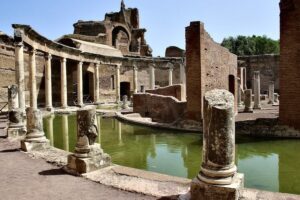
Above and below: views of the remains of the massive Villa Adriana. Above image FrDr, CC BY-SA 4.0, Wikimedia Commons
_____________________________
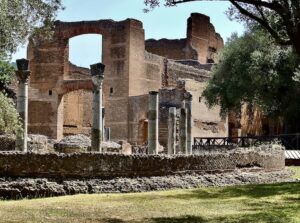
FrDr, CC BY-SA 4.0, Wikimedia Commons
_____________________________
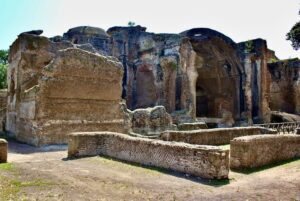
FrDr, CC BY-SA 4.0, Wikimedia Commons
_____________________________

Mosaic detail, Villa Adriana. Vassil. Public Domain, Wikimedia Commons
_____________________________

Artist reconstruction depiction of Villa Adriana. Alf.68, CC BY-SA 4.0, Wikimedia Commons
_____________________________
****
What then, in short, was the role of a villa in the life of a well-to-do Roman? To afford a brief respite out in the campagna, or by a lake or the sea or up in the mountains, while offering the pleasure of renewing oneself in solitude conducive to reflection, to reminiscing, daydreaming, relaxing; and at the same time tasting the genuine harmony of nature. Today’s Italians call this: La dolce vita di far niente – The sweet life of doing nothing.
Some owners looked at it a different way, finding their retreats to be periods of great productivity, agreeing with Cicero’s comment: “I am never less at leisure than when at leisure, nor less alone than when alone.”
Cover Image, Top Left: Women from the wall painting detail at the Villa of the Mysteries, Pompeii. Public Domain, Wikimedia Commons




